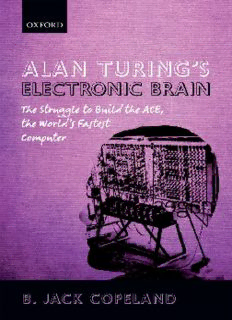
Alan Turing's Electronic Brain: The Struggle to Build the ACE, the World's Fastest Computer PDF
Preview Alan Turing's Electronic Brain: The Struggle to Build the ACE, the World's Fastest Computer
AlanTuring’sElectronicBrain This page intentionally left blank Alan Turing’s Electronic Brain The Struggle to Build the ACE, theWorld’s Fastest Computer B. Jack Copeland and others 1 3 GreatClarendonStreet,Oxfordox26dp OxfordUniversityPressisadepartmentoftheUniversityofOxford. ItfurtherstheUniversity’sobjectiveofexcellenceinresearch,scholarship, andeducationbypublishingworldwidein Oxford NewYork Auckland CapeTown DaresSalaam HongKong Karachi KualaLumpur Madrid Melbourne MexicoCity Nairobi NewDelhi Shanghai Taipei Toronto Withofficesin Argentina Austria Brazil Chile CzechRepublic France Greece Guatemala Hungary Italy Japan Poland Portugal Singapore SouthKorea Switzerland Thailand Turkey Ukraine Vietnam OxfordisaregisteredtrademarkofOxfordUniversityPress intheUKandincertainothercountries PublishedintheUnitedStates byOxfordUniversityPressInc.,NewYork ©OxfordUniversityPress2005 Themoralrightsoftheauthorhavebeenasserted DatabaserightOxfordUniversityPress(maker) FirstpublishedinhardbackasAlanTuring’sAutomaticComputingEngine2005 Firstpublishedinpaperbackin2012 Allrightsreserved.Nopartofthispublicationmaybereproduced, storedinaretrievalsystem,ortransmitted,inanyformorbyanymeans, withoutthepriorpermissioninwritingofOxfordUniversityPress, orasexpresslypermittedbylaw,orundertermsagreedwiththeappropriate reprographicsrightsorganization.Enquiriesconcerningreproduction outsidethescopeoftheaboveshouldbesenttotheRightsDepartment, OxfordUniversityPress,attheaddressabove Youmustnotcirculatethisbookinanyotherbindingorcover andyoumustimposethissameconditiononanyacquirer BritishLibraryCataloguinginPublicationData Dataavailable LibraryofCongressCataloginginPublicationData Dataavailable TypesetbyNewgenImagingSystems(P)Ltd.,Chennai,India PrintedinGreatBritain onacid-freepaperby BiddlesLtd.,King’sLynn,Norfolk ISBN 978–0–19–856593–2(Hbk) ISBN 978–0–19–960915–4(Pbk) 2 4 6 8 10 9 7 5 3 1 This is only a foretaste of what is to come, and only the shadow of whatisgoingtobe. Wehavetohavesomeexperiencewiththe machinebeforewereallyknowitscapabilities...Idonotseewhy it should not enter any one of the fields normally covered by the humanintellect,andeventuallycompeteonequalterms. AlanTuring (QuotedinTheTimes,11June1949: ‘TheMechanicalBrain’) This page intentionally left blank Foreword Donald W. Davies It was on May 10 1950 that the Pilot Model of the Automatic Computing Engine (ACE) ran its first program. This lit the lamps along the top of the control desk, one at a time, at a rate that could be controlled by the input keys. It was a great event for those who had been building the machine, simple though the program was. That small beginning culminated in the NationalPhysicalLaboratory’scommercialcomputingserviceandledonto severalrangesof computers. The Second World War saw scientific research projects of a size and complexity that reached new levels. Underlying much of the work were complex mathematical models, and the only way to get working solutions wastousenumericalmathematicsonalargescale.IntheTubeAlloysproject, forexample, whichbecametheUKpartof theManhattanProjecttomake afissionbomb, wehadtodeterminethecriticalsizeof ashapeof enriched uranium and then estimate mathematically what would happen when it exploded.Forthisproblemweusedaboutadozen‘computers’—youngmen andwomenequippedwithhandcalculators(suchastheBrunsviga).These human computers were ‘programmed’ by physicists like myself. The same story,withdifferentphysicsanddifferentmathematics,wasrepeatedinmany centresacrosstheUnitedKingdom. Inmeetingswhichbeganin1943itwasdecidedthatacentreof excellence wouldbeformed,assoonaspossibleafterthewarended,inordertodevelop numerical mathematics for peaceful applications of complex mathematical models. This centre became the Mathematics Division of the National Physical Laboratory. The Division began life in 1945 under its first superintendent,J.R.Womersley. Atthesametimetheideawasbornof buildingalarge,fast,programmed digital computer which the new Division could use to exploit its numerical expertise.TheENIACelectroniccalculatorhadilluminatedthewayforward, and there were two other major influences on this plan. One was the vii Foreword extraordinary paper written by AlanTuring in 1936, where, in the course of resolving a fundamental problem in mathematical logic, Turing had described the design of a computer that could calculate anything capable of being calculated by means of an algorithm. Turing’s design was, to an extent, idealized, but it became the basis for all the following work on programmed computation. The second major influence was the ultra- secret work on codebreaking machines at Bletchley Park, in particular the ‘Colossus’.Alarge,fastelectronicmachine,Colossuswasnotitself ageneral- purposeprogrammedcomputer,butitdemonstratedthetechnologyneeded toconvertTuring’sideasof 1936intoreality. Putting all these things together, it is not surprising that in the NPL MathematicsDivisionacomputerprojectsoonbegan,withTuringatitshead, andinvolvingtwoof thebuildersof Colossus.Turingrapidlywrotehisreport ‘ProposedElectronicCalculator’,whichsetoutadetaileddesignstudyforthe ACE.Thisbrilliantreportcoveredallaspectsofthecomputer,fromthephysics of the‘delaylines’thatformeditsmemorytotheprinciplesof programming. AlanTuringiscelebratedasagenius,bothforhismathematicalworkin1936 and later, and for his codebreaking skill, exemplified by the now famous ‘Bombe’, the machine used to break the German Enigma code. Turing’s brilliance showed again in the design of the ACE. The Pilot Model of the ACEcouldcalculatefasterthananycomputerof itsgenerationandmanyof thenextgenerationtoo. Turing was joined in 1946 by Jim Wilkinson, who would later become a world expert in matrix inversion, eigenvalue calculations, and related numerical processes. (His breakthroughs in these areas were only possible with a fast computer—the Pilot ACE—on which to test his work.) Then MikeWoodgerjoined,followedbyGeraldAlway,myself,BettyCurtis,Henry Norton,andothers.Turing’sinnovativedesignwasabrilliantstart.Moreover, wehadthemathematicianswhoweretomaketheACEintoagreatworking machine,expertisefromColossus,themajorelectronicdigitalprojectof the SecondWorldWar,andtheresourcesof theNationalPhysicalLaboratoryto fundandbuildthecomputer. But then followed an unfortunate part of the story—delays that cost us twoyears.Thechancetobethebuildersof thefirststored-programcomputer escaped us. Several things rescued us from the log-jam. A key figure was HarryHuskey,whojoinedusin1947afterworkingontheENIAC.Huskeygot thingsdoneandwithouthimanotheryearwouldhavebeenlost.Heproposed tobuildasmall-scaleversionof theACE,calledtheTestAssembly,totestthe viii Foreword electronics and construction. I’m not sure how much Turing approved of thisparticulareffort!Thenextimportantdevelopmentwastherecruitingof twoexpertelectronicengineersfromEMI,Edward(Ted)NewmanandDavid (Tubsy)Clayden.Clayden’schapter‘CircuitDesignof thePilotACEandthe BigACE’(Chapter19)describestherevolutionarystyleof logicdevicethey brought with them, employing what was called ‘current-steering’. When Huskey left us to return to the United States hisTest Assembly was partly built.AbattleensuedbetweenthosewhohadbeendesigningitandNewman, forwhomitsstyleof circuits,basedontheENIACprecedent,wasanathema. IntheendHuskey’sdesignworkwaslargelyabandoned,butnotentirelyso, for we kept to the logical design of theTest Assembly in building the Pilot ModelACE. OncethePilotModelwasworkingreliably,thewholemachinewasmoved acrosstheNPLsitefromBushyHouse, whereithadbeenconstructed, into a new room where it became a working computing service. The machine was running again a very short time after the move, a tribute to its sound engineering.Notonlywasitthefastestcomputerof itsday(andthehardest toprogram!)butwith1000electronicvalvesitwasbyfarthemostcompact. ThePilotModelACEenabledMathematicsDivisiontomakegreatadvances in numerical analysis, and provided industry with the first commercial electroniccomputingservice. Themainhonoursforthedesignandconstructionof thePilotModelACE aresharedbyAlanM.Turing,JamesH.Wilkinson,andEdwardA.Newman, aided by a sharp nudge from Harry D. Huskey, who really started the Pilot Modelidearolling. ix
Description: